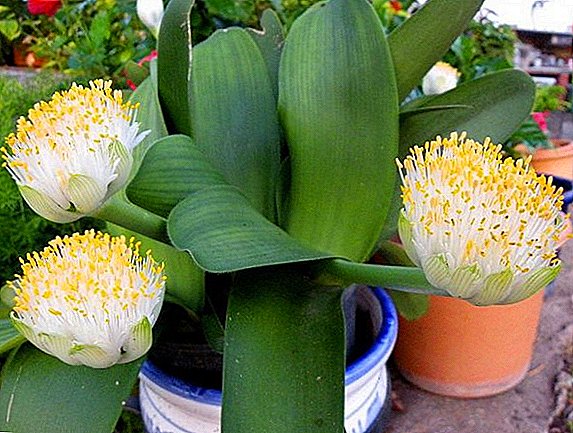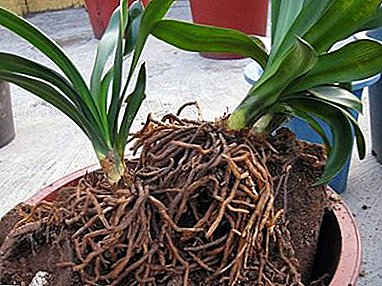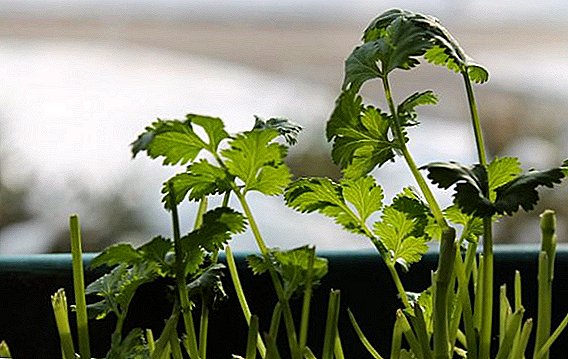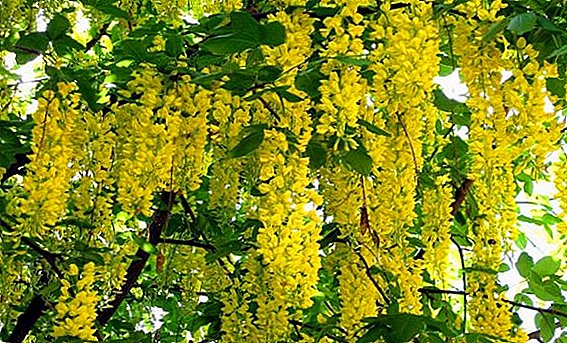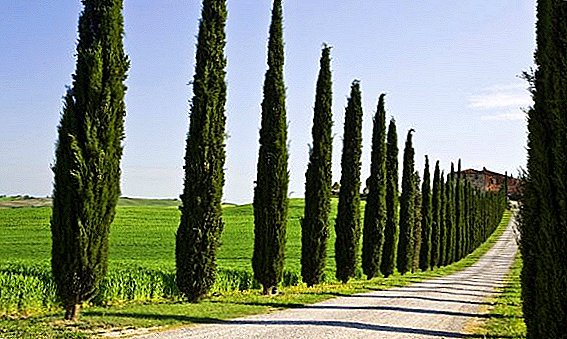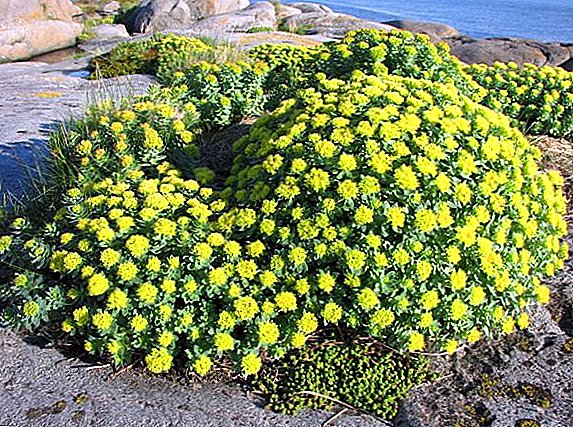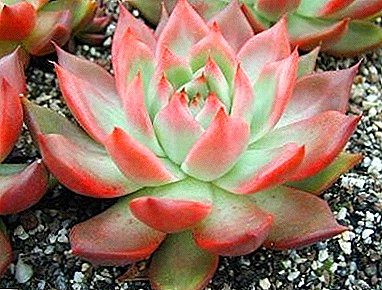
Echeveriaor how often it is called stone rose. Indeed, by its appearance the plant resembles a rose, and because of its thick, fleshy leaves, it is as if made of stone. As a typical representative of succulents, the echeveria is unpretentious, which means that an amateur grower can handle it.
A photo
See more photos of Echeveria:





Home care
Optimal conditions of detention
 Light mode. Echeveria loves a lot of light. The window prefers facing south. The leaves of the plant are covered with a waxy bloom, which play the role of a shield, so partial exposure to direct sunlight is not dangerous.
Light mode. Echeveria loves a lot of light. The window prefers facing south. The leaves of the plant are covered with a waxy bloom, which play the role of a shield, so partial exposure to direct sunlight is not dangerous.
Temperature. Stone Flower - Plant thermophilictherefore, the temperature from +22 to +28 degrees is optimal. But a slight increase or decrease also tolerates quite easily.
Humidity. Flower prefers dry climate with lowered humidity. Does not need spraying.
Watering should be moderate. Spring - summer - once a week. Autumn - once a month. A large amount of water will destroy the plant, and the lack will lead to the folding of the leaves. The top layer of the soil should dry well. Use soft water, preferably distilled.
Top dressing
Echeveria does not need frequent fertilizer. Once a month from March to September will be enough. The best option would be fertilizers for succulents or cacti, for example, AQUICOLA AQUA FOR CACTUSES AND SUCCULENTS. Use the fertilizer itself two times less than the instructions, and the same amount of water.
Bloom

On the sides of the plant appear arrow-flower stalks. Their length can be from 5 to 50 cm, and in some species up to 90 cm. At the end of these arrows there are small rosettes of leaves.
The flowers are shaped like bells, collected in small inflorescences. Coloring can be from yellow-green to pastel-orange. On the sepals of flowers, ka and on the leaves is observed velvety fluff or wax coating. And if cross-pollination occurs, fruits will appear in the form of pentahedral bolls containing small seeds.
With favorable content, flowering occurs in the spring-summer period and lasts quite long. But there are species that can begin to bloom and by the end of January (you can learn about the types of Echeveria, as well as see photos of the flower, here).
After flowering long shoots are pruned. They can be transplanted separately for rooting.
Rest period
Like the rest of the succulents, Winter for "Stone Rose" - a period of peace. It is necessary for the plant to rest and gain strength for flowering. The temperature is better to reduce to +10 - +11 degrees. Reduce watering. Fertilizers in this period do not contribute.
How to care in the open field?

Usually, Echeveria sockets are used as borders to create perfect clear outlines of compositions from annual flowers. Effectively looks on the Alpine hills among stones. Planted plants in the beginning of May. Small night frosts tolerate not bad, but you should not sit on a large open area.
Care also consists in watering and top dressing. It grows well in a small shade of neighboring flowers on sandy, drained soil, without water accumulation.
By mid-September, the plant needs to be transplanted back to the vases, but it is necessary to accustom the eheveriya to home conditions after such a summer. First come glassed porch or balcony.
Diseases and pests
 Fungal diseases: late blight - the appearance of brown spots on the leaves, further rotting of the stem. It should be treated with soda solution - 1 tsp. 0.5 liters of water. From chemical agents suitable copper sulphate, Bordeaux mixture, green soap. Remove badly damaged area. Plant transplanted by washing the root system with running water.
Fungal diseases: late blight - the appearance of brown spots on the leaves, further rotting of the stem. It should be treated with soda solution - 1 tsp. 0.5 liters of water. From chemical agents suitable copper sulphate, Bordeaux mixture, green soap. Remove badly damaged area. Plant transplanted by washing the root system with running water.
Root rot mainly affects young shoots or weakened plants. The plant dies off at the root. The treatment can be used the same as with late blight.
Rootbird and gall nematodes - parasites, in the form of very small worms, directly affect the root system of a plant. Symptoms of the manifestation are approximately the same: a slowdown in growth, the leaves lighten or turn yellow, they can wrinkle, a gray patina on the roots, on the edge of the earth a thick white-gray. Before transplanting into a new soil, the roots should be thoroughly washed in hot water +55. To process the plant Aktelik or Fitoverm, but unfortunately the flower with a strong defeat can not be saved.
Although Echeveria is called the "Stone Rose", in fact it is a very elegant, tender and fragile plant that surprises with its appearance at home and in the garden.
Breeding
 Seeds. Produced in early spring. Sand and peat 1: 1 are poured into a small container, and seeds are planted. Make a small greenhouse using film or glass. Sprayed frequently. After a couple of weeks, the first shoots will appear. When a little grow up, it is necessary to plant separately in small pots with a mixture of sand and leafy ground. Only when the echeveria is 3-4 cm in diameter will it be transplanted into real soil.
Seeds. Produced in early spring. Sand and peat 1: 1 are poured into a small container, and seeds are planted. Make a small greenhouse using film or glass. Sprayed frequently. After a couple of weeks, the first shoots will appear. When a little grow up, it is necessary to plant separately in small pots with a mixture of sand and leafy ground. Only when the echeveria is 3-4 cm in diameter will it be transplanted into real soil.
Cuttings. Cuttings that have not reached 10 cm are cut and added dropwise with a mixture of sand and compost. Rooted pretty quickly.
Leaf segments. Take healthy lower leaves. They need a little dry. Then place in a container with sand and soil. Watering moderate, neat. The roots will appear in a week.
Peduncle. After cutting, the shoots need to be dried. Cut the cut with coal or ashes and place in a small container with the usual mixture for planting.
Child Outlets, which are also dried and placed to root in a wet mixture of sand and vermiculite. <
Planting a stone rose
After purchase and with further transplantswhich are best produced annually in the spring, first of all carefully inspect the root system. Roots that have begun to rot or have dried should be removed with a sharp object treated with alcohol, taking a healthy patch of root by 2 cm. The cut place should be well treated with charcoal or ash. Replace should be carefully, so as not to damage the leaves of the plant.
 Priming. For this plant fits the following mixture: the main part is leafy ground, and then in equal quantities: turf, dry clay and sand.
Priming. For this plant fits the following mixture: the main part is leafy ground, and then in equal quantities: turf, dry clay and sand.
To avoid reproduction of dangerous microorganismsThis mixture is best boiled for 30 minutes in a water bath. 1/3 of the pot must be filled with a drainage made of pebbles, broken bricks or expanded clay.
Pot. From purchased and subsequent, each pot should be 2 cm larger than the previous one, since the root system of succulents grows slowly. Drainage holes and drain pan are also important in order to avoid stagnant water. So that the soil dries faster, the pot resembles a bowl. But ceramic or plastic - the choice is yours.
It is better that the container is light, which will save the flower from overheating in the summer.


